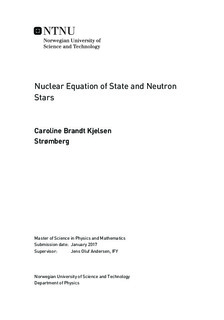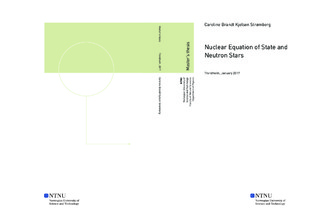| dc.contributor.advisor | Andersen, Jens Oluf | |
| dc.contributor.author | Strømberg, Caroline Brandt Kjelsen | |
| dc.date.accessioned | 2017-03-10T16:00:00Z | |
| dc.date.available | 2017-03-10T16:00:00Z | |
| dc.date.created | 2017-01-15 | |
| dc.date.issued | 2017 | |
| dc.identifier | ntnudaim:16168 | |
| dc.identifier.uri | http://hdl.handle.net/11250/2433719 | |
| dc.description.abstract | In this thesis, we study the mass-radius relation of neutron stars. This relation is computed using stellar structure equations and an equation of state. We use the Tolman-Oppenheimer-Volkoff (TOV) equation and the mass continuity equation as stellar structure equations. Using quantum field theory, we find the equation of state of an ideal gas of fermions. Interactions between the fermions are included using the $\sigma$-$\omega$ model, where we introduce mesons in a mean-field approximation. We also look at how the model can be extended by including scalar self-interactions and isospin force. Leptons are also included in order to impose electrical neutrality. We solve the equation of state for the $\sigma$-$\omega$ model numerically, and use it to solve the TOV and mass continuity equations for a given central pressure. Solving the equations for a range of central pressures gives us the mass-radius relation of neutron stars. It has a maximum mass $M_{\mathrm{max}}=2.595 M_{\odot}$ for a radius $R_{\mathrm{max}}=12.64$ \si{km}. This means that there is an upper bound on the mass of a neutron star, and beyond this limit, the neutron star is unstable and will continue to collapse into a black hole. | |
| dc.language | eng | |
| dc.publisher | NTNU | |
| dc.subject | Fysikk og matematikk, Teknisk fysikk | |
| dc.title | Nuclear Equation of State and Neutron Stars | |
| dc.type | Master thesis | |

